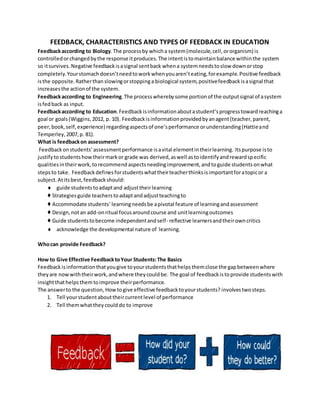
Feedback, characteristics and types of feedback
- 1. FEEDBACK, CHARACTERISTICS AND TYPES OF FEEDBACK IN EDUCATION Feedbackaccording to Biology.The processby whicha system(molecule,cell,ororganism) is controlledorchangedbythe response itproduces.The intentistomaintainbalance withinthe system so itsurvives.Negative feedbackisasignal sentback whena systemneedstoslow downorstop completely.Yourstomachdoesn’tneedtoworkwhenyouaren’teating,forexample.Positive feedback isthe opposite.Ratherthanslowingorstoppinga biological system,positivefeedbackisasignal that increasesthe actionof the system. Feedbackaccording to Engineering.The processwherebysome portionof the outputsignal of asystem isfedback as input. Feedbackaccording to Education.Feedback isinformationaboutastudent’sprogresstowardreachinga goal or goals(Wiggins,2012, p. 10). Feedbackisinformationprovidedbyanagent(teacher,parent, peer,book,self,experience) regardingaspectsof one’sperformance orunderstanding(Hattieand Temperley,2007,p. 81). What is feedbackon assessment? Feedbackonstudents’assessmentperformance isavital elementintheirlearning. Itspurpose isto justifytostudentshowtheirmarkor grade was derived,aswell astoidentifyandrewardspecific qualitiesintheirwork,torecommendaspectsneedingimprovement,andtoguide studentsonwhat stepsto take. Feedbackdefinesforstudentswhattheirteacherthinksisimportantforatopicor a subject.Atitsbest,feedbackshould: guide studentstoadaptand adjusttheirlearning ♦ Strategiesguide teacherstoadaptandadjustteachingto ♦ Accommodate students’learningneedsbe apivotal feature of learningandassessment ♦ Design,notan add-onritual focusaroundcourse and unitlearningoutcomes ♦ Guide studentstobecome independentandself- reflective learnersandtheirowncritics acknowledge the developmental nature of learning. Whocan provide Feedback? How to Give Effective FeedbacktoYour Students:The Basics Feedback isinformationthatyougive toyourstudentsthathelpsthemclose the gapbetweenwhere theyare nowwiththeirwork,andwhere theycouldbe. The goal of feedbackistoprovide studentswith insightthathelpsthemtoimprove theirperformance. The answerto the question, Howtogive effective feedbacktoyourstudents? involvestwosteps. 1. Tell yourstudentabouttheircurrentlevel of performance 2. Tell themwhattheycoulddo to improve
- 2. Characteristics of effective feedbackonassessment To addressthe typical concernsandproblemsencounteredbystudentsandstaff withassessment feedback,the followingprinciplescanbe usedtoguide the processesof preparingandproviding feedback: Feedbackshouldbe part ofthe assessmentdesign, withthe processesof receivingand respondingtofeedbackbuiltintoandmade explicitinsubsequentlearningexperiencesand grading. Feedbackshouldbe constructive, so that studentsfeel encouragedandmotivatedtoimprove theirpractice,andcontributingto theirpositive self-esteemaslearners. Feedbackshouldbe timely,sothat studentscanuse it for subsequentlearningandworktobe submitted. Feedbackshouldbe prompt, so thatstudentscan recall whattheydidand thoughtat the time. Feedbackshouldbe justified,bybeingbasedonclearandexplicitexplanationsof performance againststatedcriteriaandstandards. Feedbackshouldbe supportive of learning,sothat studentshave clearindicationsof howto improve theirperformanceinadevelopmentalprogression. Feedbackshouldbe focused, onachievement,noteffort;andonthe work,not the student. Feedbackshouldbe expressedintermsof the learning outcomes,so that studentscan relate theirassessmentto the learningoutcomes,seeinghow theycanclose the gap betweentheir currentand theirdesiredachievementof these outcomes. Feedbackshouldbe consequential,sothat itengagesstudentsbyrequiringthemtoattendto the feedbackaspart of the grading. Feedbackshouldbe focusedon independence, sothatit leadsstudentstobeingcapable of assessingtheirownwork,byfacilitatingtheirdevelopmentof critical reflectionand self- assessment. Feedbackshouldbe efficient, sothatstaff can manage it effectively. Feedbackis NOT editing,spell-checkingorgrammar-checking. Studentsshouldbe requiredto edittheirownwork,andwhere possible toresubmiteditedworkbasedonfeedbackaboutwhat needstobe done. Self-regulation–feedbackshouldencourage the learner’sself-regulationbyenhancingself- efficacyandself-esteem.Thisconceptcorrespondswithteachinglearnershow tolearn.
- 3. Types offeedback 1. Feedbackduring learning– Formative Feedback Feedbackduringlearningallowsstudentstotake feedbackonboardimmediatelyandtotry to realize improvementduringthe learningprocess. Thisis oftenmore effective andproductivetothe learningexperience thanend-of taskfeedback measures(usuallysummative),whichrequire studentstorememberthe feedbackandapplythe recommendedstrategiestoa future task. 2. Feedbackafter learning– Summative Feedback Too oftenfeedbackthatisprovidedtostudentsafterlearning hasconcludedisnotusedbythe students to improve theirwork.Thisoftenresultsinteachersmakingthe same commentsoverandoveragain and wonderingwhythe studenthasnottransferredthe informationtoanothercontext.Forsuch feedbacktoinfluence subsequentlearning,studentsmustrememberit,translate itintoadvice thatis transferable acrosstasks,andapplyitthe nexttime theyencounteratask inwhichthislearningcould apply.Generally,while strongstudentscanoftendothis,strugglingstudentsfinditmore difficult. ©Feedbackduringandafterlearningshould: • Focuson whatis beinglearnt(learningintention) andhow studentsshouldgoaboutit(success criteria) • Provide informationonhowandwhythe studenthasor has not met the criteria • Provide strategiestohelpthe studenttoimprove. 3. Formal feedback Formal feedbackcanbe providedthroughstructuredconferenceswithspecificgoals. Teacherscan meetwitha fewstudentsaday or a weekdependingonspecificprojects, deadlines,and individualstudentneeds. It isimportantto setup these conferencesinastructuredwaywitha focus on individualized goalsso bothteacherand studentmake gooduse of theirtime. Hintsfor student-teacherconferences: • Lookat studentworkbeforehand • Use a checklistorfeedbackformthatstudentscanuse as a reference formakingrevisions • Focuson twoto three itemsthatneedworkand show how to improve them • Make time for the studenttoask questionsandgive input. Whenteachersuse formal conferencingalongwithinformalfeedback,studentsare betterprotected fromfailure andsetup forsuccess. 4. Informal Feedback Informal feedbackcanoccurat anytimesas itis somethingthatemergesspontaneouslyinthe moment or duringaction.Therefore informalfeedbackrequiresthe buildingof rapportwithstudentstoeffectively encourage,coachor guide themindailymanagementanddecision-makingforlearning. Thismightoccur inthe classroom,overthe phone, inanonline forumorvirtual classroom. 5. StudentPeer feedback There isno longerneedforteacherstobe the onlyexpertswithinacourse.Withbasicinstructionandongoing support,studentscanlearnto give qualityfeedback,whichishighlyvaluedby peers.Providingstudentswithregular opportunitiestogive andreceive peerfeedbackenrichestheirlearningexperiencesanddevelops theirprofessionalskillset.
- 4. 6. Constructive feedback Thistype of feedbackisspecific,issue-focusedandbased onobservations.There are fourtypesof constructive feedback: Negative feedback – corrective comments about past behavior. Focuses on behavior that wasn’t successful and shouldn’t be repeated. Positive feedback – supporting comments about past behavior. Focuses on behavior that was successful and should be continued. Negative feedforward – corrective comments about future performance. Focuses on behavior that should be avoided in the future. Positive feedforward – encouraging comments about future behavior. Focused on behavior that will improve performance in the future. 7. Intrinsicfeedback:It is feedbackfrom one’sownself e.g.apersonengagedinthinkingand ponderingoverideas,evaluatingoptionsandassessingtheiroutcomes. Examples” For simple tasks,youcan dothisthrough providingthe answer.Youcouldhighlighta misspellingandwrite the correctspellingabove it,ormarka questionwrongwhile alsoprovidingthe rightanswer.”